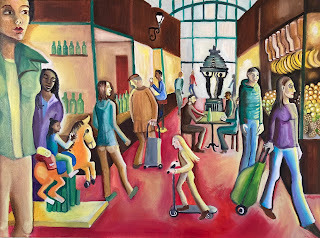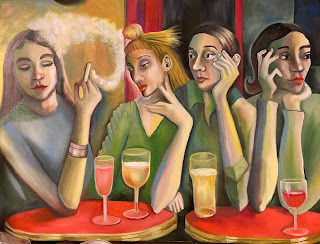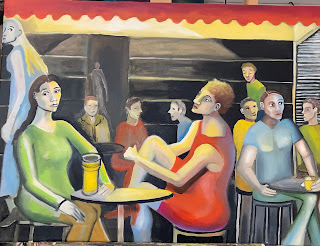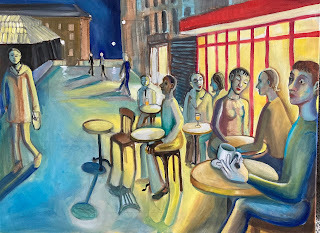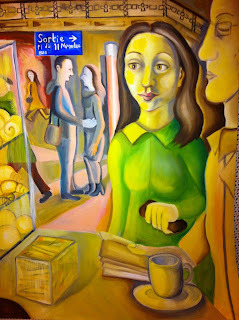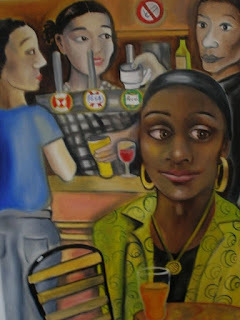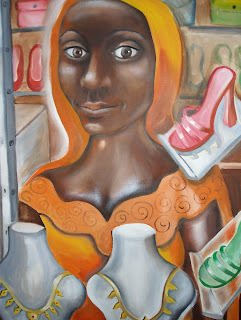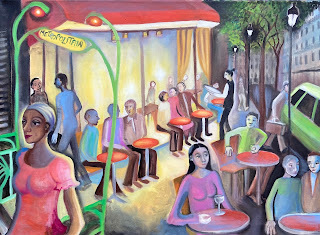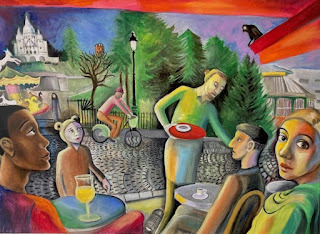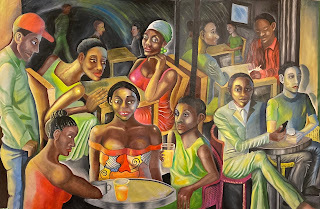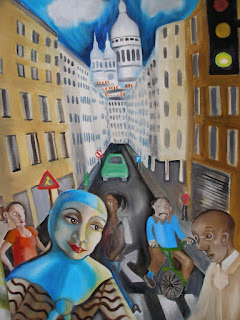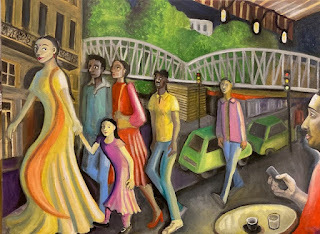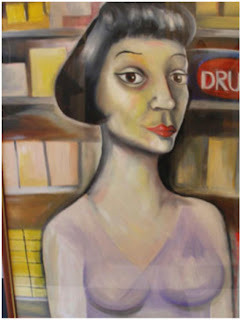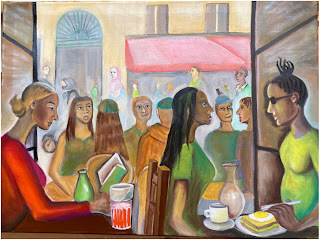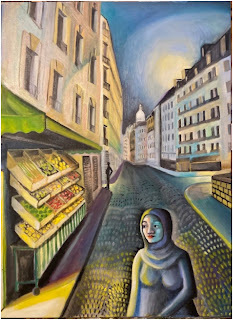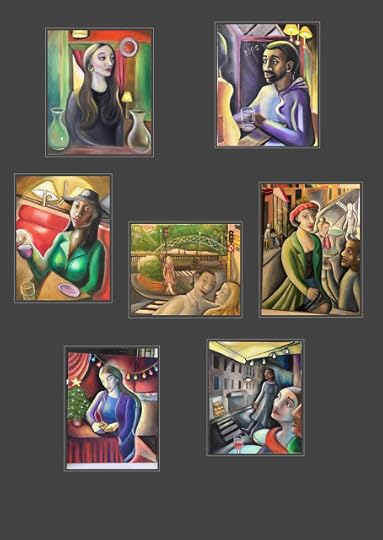Keziah Shepherd's Blog
June 19, 2023
Tarif de Peintures, Palais du Louxor
Published on June 19, 2023 08:20
February 19, 2020
March 17, 2019
Images of people in Paris
Published on March 17, 2019 05:07
March 16, 2019
A Bradford Childhood: the date
Chapter 1My hair reeked of hair spray as I stood between the photo booth and the automatic doors in Bradford Bus Station, waiting for Matthew Clayton. A man glanced at me and cocked his head.“Waiting for lover boy?”“No,” I said, my face burning hot.“Then will I do?” he said putting on a spaniel look in jest. I looked away. I was a 17 year old, stunted, spotty and shy girl, forgotten by boys and most people whereas Matthew Clayton was the most popular boy in the class, the wildest and the one wanted by all the girls and I’d asked him on a date.I must have lost my mind. Mrs Drew had been doing her lecture on Cubism and I had noticed Matthew Clayton’s Adam’s Apple. It pulsed out of his soft neck. His jaws were now a little prickly where he’d started to shave and where his tartan shirt collar opened out I could see the nook of his throat and some soft squiggly hairs on his chest. He asked questions with a pleasant maturity about him: a free-spirited lightness to his voice so different from many of the programmed kids who had little ventured from their parents’ mindsets. I found my stare lingering on him – observing the soft spikiness of his hair and the gentle blue of his eyes. His presence caused a perky feeling to my spirits and the dreary groundhog nature of life was given a tonic by his presence.Plus he played an electric guitar and there was something star struck about us all as he talked about his gigs and fans. I imagined him on stage, playing his guitar and bouncing to the rock music and my heart seemed to swoon inside, a dizzy-like drunkenness. His artwork was done with this delicate pen and coloured with watercolours. I felt too shy to speak to him and kept to the other side of the classroom, blushing and confused.As I looked about for Matthew Clayton the green double-decker buses arrived and left, blood corpuscles in veins and arteries. They joined the heather laden moors to the inner city warehouses. People flowed into Bradford for an evening of fun: women wore their best high heels and men newly washed and combed.
*
When I was younger I had found a photograph of a man, hidden in a drawer. He was blond haired with blue eyes, attractive and sexy. He had a dreamy and sleepy look, ‘short back and sides’ not like the long hair and long beards of that time.I had gone to my mother to ask about him.“Mum, who is this man in the black and white photo?” I asked.“Man?” she says, “what man?” and she looked at me startled.“There’s a photo of a man, hidden in a red purse?” I said. As soon as I said ‘red purse’ my mother went quiet.“What are you doing nosing about in that drawer?” she said.“I wasn’t nosing!” I was at an age where my mother’s clothes and handbags and shoes were an excitement to explore and dress up in. I would pretend I was someone else and loved their smell and their colours. My mother had gone into a mood and was not answering me so I glanced up at her face. She had gone quiet and something in her voice had sounded stiff and sorrowful, as if I’d awakened some wounded part in her past. When my mother again she didn’t answer I felt uncomfortable so I took the photo back to its hiding place.However a few days later, I decided to ask again while we were walking home from school. I took hold of her large sausage sized fingers, the nicely manicured nails and the jingle of bangles on her wrist and said:“Who was he?” I was walking quietly at her side, waiting for her to begin the story. By now we were on the back lane and the muddy path with grassy edges were feather soft. Green tomatoes in the glass house on the left were turning more red each day and the lettuces, small as fists, were growing larger too, frilling out like a lady’s green petticoats.My mother felt my small hand in hers.“Who was who?” she said. Nothing is greater than palm to palm, my match stick finger bones in her large polish sausages bones, lifelines activated and fingers crowned and ringed with gold bands. My fingers linked into her hand, small as tendrils, sipping up the warmth and nectar my mother gave.“That man in the photo” I said. The sun in the garden was the colour of golden syrup and we could hear the clink of pans in the back kitchens. A scribble of untended brambles with bucket loads of blackberries bulged on our left and the walls of coalholes on our right.“Oh he was just a man,” she said finally.“Which man?” I asked, impatiently. “Was he a boyfriend or just a friend? Was he a friend of my dad?”“Oh it doesn’t matter,” she said quickly. “He wasn’t important” and she let go of my hand.We came to the row of terrace houses now. Ours was the sixth one along. She descended the steps to the yard to unlock the back door.“Omelette or frankfurters?” she said, changing the subject. I stood and watched her go into the house and I wondered if the happy endings in the fairy tale stories were not real. I wondered if my mother had been hurt by love?
*
My father was not handsome or sexy like the man in the photo and I wondered how he had won over my mother?He was a different kind of man: with his National Health spectacles, long side-burns and tall, lank body. His values were being compassionate and having empathy, believing it made a better society then being rich but had my mother stayed with him all these years out of love?When they met he had insisted to my mother that they would stay in London and that he would pass his lawyer’s exams. This would enable them to pay the high London rent of their Battersea apartment.But after they were married, he had failed his law exams.“I’m sorry, darling,” my father said to my mother, after a long silence.“Well it’s not the end of the world,” my mother answered, looking as if it was. She looked my two brothers playing on the floor of the flat anxiously.“We will have to find another place to live” My father looked so pained.They had had to move north, into a temporary flat in Bradford where they could afford the rent and my father could work as a clerk and study for his solicitor finals at the same time.It was a long way north and Bradford was black as coal.“I thought the buildings were made of coal,” my father said wondrously, when they arrived there for the first time.The Yorkshire coalmines were not far away and the tower of Lister’s Mill, once largest silk factory in the world, loomed above their new flat, black as pitch.My mother wasn’t sure it would work out. It was a small flat next to the two-up two-downs that formed row after row near the Bradford mills. Mirpuris and Kashmiris had also just moved into their colonial motherland. Perhaps they had expected to see the pageantry of Elizabeth, where all the streets were paved with gold?Bradford’s cars and electric lights and its cold, dark, smoky reality was a rude awakening. The blackened brick terrace houses seemed to go on forever and cobbled streets lay around them. Some of the back-to-backs were like slums with poor hygiene, health and diet.My father got up early in the morning to go to work as milk bottles clanked and the postman went from post box to post box on the streets, listening to the Western radio, interspersed with music made by the sitar. People set off for their long, hard, dirty shifts working in the wool mills and on the Bradford buses.At the end of the day my father studied for his law exams and at night returned home when the orange streetlights were already alight so that it looked like a field of flower heads.“You were conceived at this time,” my father told me, “on a cold, winter night when we were trying to keep warm” my father laughed.“You were not a planned baby,” my mother said to me.Eventually my father re-sat his law finals hoping to have passed.
*
My mother used to push us in a big pram over cobbles and bumpy lanes laden with baskets full of potatoes and fruit from Kirkgate Market.They say it’s a holy family and families are meant to love each other but certain clues began to appear in those early years of sibling enmity.Daniel, the younger of my two elder brothers had a special valet seat at the front of the pram and Sebastian would hold the bar and walk at the side. I loved hearing my brothers’ voices and felt a benign connection joining my heart to those boys’ voices, like a holy family.But then my mother left me alone on the table one day, to go off to fetch a nappy pin, and Daniel walked in. Some moments later she heard me crying loudly and coming back, she found Daniel looking meekly at her and I: lying on the floor.“Oh my god” she said, scooping me up worriedly. She never understood until this day if I had cried so he had reached to help me and dropped me or if he had pulled me off the table in full gladiator onslaught causing me to cry.My mother watched Daniel thoughtfully.“How can he feel loved, while the new baby is taking all the attention?” He chewed on his piece of bread, a happy baby, who had invented his own language that no one understood, except for the word ‘clacks’ which meant lights. He had thick, golden, ginger hair, big blue eyes and plump cheeks and consumed maybe a loaf of bread a day, grinning as soon as a large crust was put into his baby fingers to maul and lick.“How can we help Daniel feel noticed as much as before?” she said, looking at my father.
*
I was the third child and born in my parents’ bedroom. A home-birth was normal in those days and they’d not expected difficulties. The TV was on while my mother was in labour. The midwife had driven up from the Bradford Royal Infirmary in an old Austen car. My parents’ room had purple, blue and green flowered wallpaper and as my mother pushed and huffed on the bed, and I was pulled out by pinchers.Then my father turned off the television to watch my arrival but I was a yellow, strangled thing with the umbilical cord wrapped around my neck: a scraggly looking creature, looked set to die right then.Apparently there was some commotion and then I turned blue. Hurriedly, my cord was snipped, and my colour returned and kicked weakly in a Moses basket placed on my parents’ bedroom floor as the oxygen filled me. I was given bottled milk to suck on because my mouth made my mother’s nipples sore. Then while the bloody bed sheets were changed and my mother went to sleep exhausted, the nurse seemed satisfied enough that I would live and left soon after.My parents watched me blankly in a void of girls’ names, for they had planned on calling me Adam and never thought I might be a girl. The black sky was encrusted with stars and I was born like another grain of sand or another star.
Over the days that followed, rain tapped as loudly as a spoon on my pram roof and dazzling light would break into my sealed interior, where all outside sounds were muffled. Summer birds sang so loudly, each species sending its Morse codes into the air. Daisies teemed with yellow centres as wide as eyeballs, bowing their headdress of white petals. August greenery was viridian and emerald, malachite and lime and its large, hand sized leaves waved above my pram, heaving with life and fused with an electric potency that fused my own blood. Vast and huge, an azure blue sky, racing with diaphanous white clouds travelled over the roof.Large, hairy hands and a prickled chin and glasses would be there, and then a skin which smelt of lemon face cream, and eyes that were cornflower blue before the wheels of the pram were folded and carried up the stairs.Those early years I stayed with my mother in that house, knowing little beyond it. I toiled for hours, filling containers with water and putting hats on my head. The house had soft wooden floors for walking attempts and proved gentle for those early manoeuvres. Banister rails could be grabbed while mounting stairways and the soft sandstone flags were soft on bumping bones.Boxes of fascinating bricks, dolls, boxes and rattles were pulled and explored. Our gummy mouths sucked rusks and there was hot milk by the coal stove at teatime. I tried reaching for my milk bottle; the doorways were patiently knocked and chipped by wooden wheelie toys.I remember the ‘baa’ of sheep, sunrays lighting up a yellow wall or the scent of farmyards from a cottage in Wales.
A Bradford Childhood by Keziah Shepherd

Published on March 16, 2019 17:11
March 23, 2017
Frida Kahlo: the qualities of a Saint?
In Mexico City, Frida Kahlo’s image is everywhere. Every bus, every handbag, every poster and billboard, there she is, looking out at you, just like Mona Lisa.
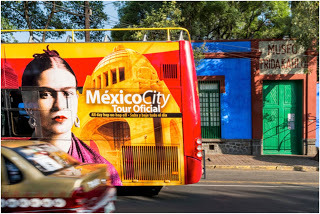 I wondered ‘Who would have thought of it back then in her day?’ She is almost saint-like.It struck me that some women, Joan of Arc, Mother Theresa, some women seem to rise up and resonate for centuries. Their paths take a heaven-bound route, the way of a flight of wild geese, leaving the earth far behind. What is it about Frida Kahlo that has resonated so? I went to her house in Mexico City like a pilgrim, sort of to find out. This visit, like a visit to Mecca, was one of my life dreams.Her house was painted an electric blue. It was the colour popular of indigenous culture – representing purity, love and electricity. While lizards running by, she’d learnt to paint on its patio.
I wondered ‘Who would have thought of it back then in her day?’ She is almost saint-like.It struck me that some women, Joan of Arc, Mother Theresa, some women seem to rise up and resonate for centuries. Their paths take a heaven-bound route, the way of a flight of wild geese, leaving the earth far behind. What is it about Frida Kahlo that has resonated so? I went to her house in Mexico City like a pilgrim, sort of to find out. This visit, like a visit to Mecca, was one of my life dreams.Her house was painted an electric blue. It was the colour popular of indigenous culture – representing purity, love and electricity. While lizards running by, she’d learnt to paint on its patio.
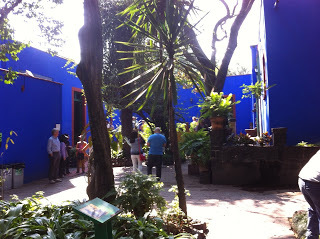 Going into the house, I found myself in Frida’s private world. Here are the paintings she said could never leave it. They are so deeply personal, and were, in her life time, considered too intimist and therefore not up to Diego’s standards.She was born in the blue house in 1907. She was the 3rd of 4 daughters. Her father was a photographer.
Going into the house, I found myself in Frida’s private world. Here are the paintings she said could never leave it. They are so deeply personal, and were, in her life time, considered too intimist and therefore not up to Diego’s standards.She was born in the blue house in 1907. She was the 3rd of 4 daughters. Her father was a photographer.
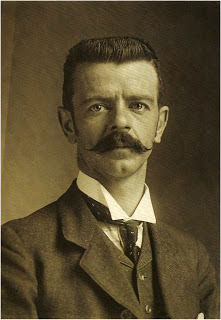 Guillermo Kahlor
Guillermo KahlorFrida shared her father’s passion and intensity and he recognised her talent.“He was an immense example of tenderness” she said of him.
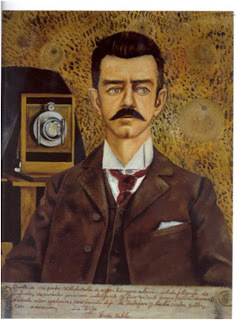 Pattern behind is like cells under a microscope given by her father who encouraged her medicine.She believed that social equality is the key to a better life. Nobody fights for himself – everything is all and me.
Pattern behind is like cells under a microscope given by her father who encouraged her medicine.She believed that social equality is the key to a better life. Nobody fights for himself – everything is all and me.
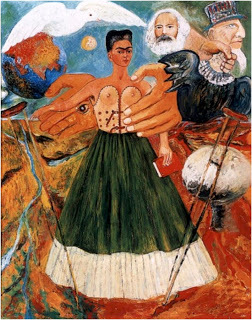 “Marxism will give health to the sick” In this painting the eagle in this painting is the symbol of capitalism. The working man is in danger of being its prey. The important way to fight capitalism was to say was ‘we’ and NOT ‘I’When she married Diego they would live in the house between 1929 and 1954. Rivera was a national hero when they met. They were both deeply committed to same ideals. He was twenty-one years older, 200 pounds heavier, and, at more than six feet, nearly 12 inches taller than she, gargantuan in both scale and appetites. As irresistible as he was ugly, Rivera was described by Frida as “a boy frog standing on his hind legs”It was obvious, despite the battles of ego the two suffered, that her and Diego attained a rare love and respect. Diego told her she was a good painter and told her all the time.One of the pieces in the house speak of their love. ‘Two clocks’ (left is time of divorce and right is when reunited again) It is called “Time works again”
“Marxism will give health to the sick” In this painting the eagle in this painting is the symbol of capitalism. The working man is in danger of being its prey. The important way to fight capitalism was to say was ‘we’ and NOT ‘I’When she married Diego they would live in the house between 1929 and 1954. Rivera was a national hero when they met. They were both deeply committed to same ideals. He was twenty-one years older, 200 pounds heavier, and, at more than six feet, nearly 12 inches taller than she, gargantuan in both scale and appetites. As irresistible as he was ugly, Rivera was described by Frida as “a boy frog standing on his hind legs”It was obvious, despite the battles of ego the two suffered, that her and Diego attained a rare love and respect. Diego told her she was a good painter and told her all the time.One of the pieces in the house speak of their love. ‘Two clocks’ (left is time of divorce and right is when reunited again) It is called “Time works again”
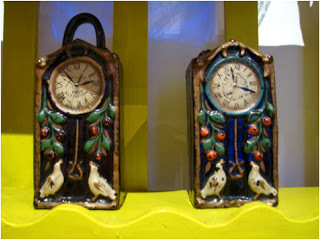 Both had many lovers but no-one could separate our fountains of love.However, Kahlo’s paintings also speak of issues society chooses to hide: her unspoken miscarriage and infidelity. We learn from them of her sorrow, in which she expresses the grief she felt when, just before her toes were amputated Diego was having affaire with her sister. This was in 1935 and she didn’t paint for a year."Still-life in wooden frame" alludes to the womb. This was a commission rejected because of its reference to the female sexual organ.
Both had many lovers but no-one could separate our fountains of love.However, Kahlo’s paintings also speak of issues society chooses to hide: her unspoken miscarriage and infidelity. We learn from them of her sorrow, in which she expresses the grief she felt when, just before her toes were amputated Diego was having affaire with her sister. This was in 1935 and she didn’t paint for a year."Still-life in wooden frame" alludes to the womb. This was a commission rejected because of its reference to the female sexual organ.
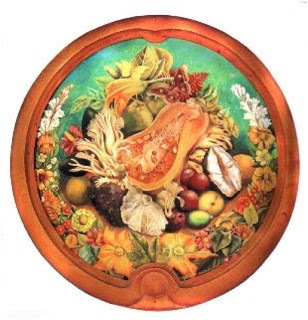 Other paintings spoke of her strong will to live, despite the pain of operations on her back.“Long live life” shows her passion to create.
Other paintings spoke of her strong will to live, despite the pain of operations on her back.“Long live life” shows her passion to create.
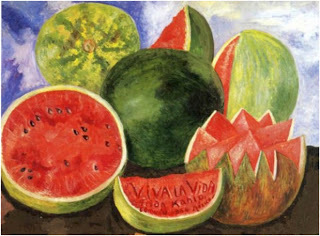 She said that: “I am happy to be alive as long as I can paint” “Who needs feet when I’ve got wings to fly”She tried to disguise the short leg, with its long heal by wearing long dresses. Working as a teacher at National Painting and Sculpture School, the students would instead notice the sound of bells ringing on her indigenous clothes and the students also noticed her unibrow.Some of her paintings were similar to Ex Votums – Votas. Ex-Votos are images offered to a saint or the Madonna as a thank you for an answered prayer. In most cases, the Ex-Vota is signed by the supplicant and dated, and explains why the giver is giving thanks. In many cases, they tell a very touching personal story. “I thank our lady for saving me”
She said that: “I am happy to be alive as long as I can paint” “Who needs feet when I’ve got wings to fly”She tried to disguise the short leg, with its long heal by wearing long dresses. Working as a teacher at National Painting and Sculpture School, the students would instead notice the sound of bells ringing on her indigenous clothes and the students also noticed her unibrow.Some of her paintings were similar to Ex Votums – Votas. Ex-Votos are images offered to a saint or the Madonna as a thank you for an answered prayer. In most cases, the Ex-Vota is signed by the supplicant and dated, and explains why the giver is giving thanks. In many cases, they tell a very touching personal story. “I thank our lady for saving me”
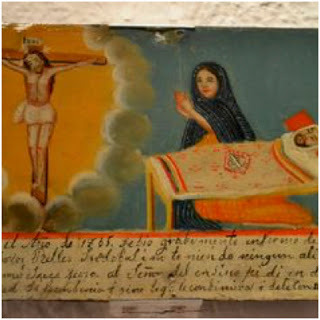 Frida collected the ones of people who had accidents and was interested in lives of real people.
Frida collected the ones of people who had accidents and was interested in lives of real people.
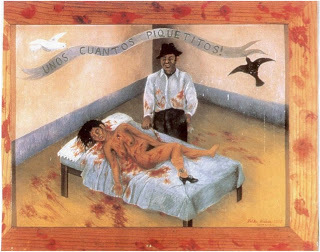 She also collected other things, photos (6000), skeletons and skulls, popular art (a common theme in her work) papier-maché Judas figures which were loaded with fire-works and exploded to mock Judas and mermaids (popular art) because their bodies were broken and Frida identified with them.She was active in the Mexican Communist Party. Trotsky lived in her house for two years – sharing political passions with the couple.
She also collected other things, photos (6000), skeletons and skulls, popular art (a common theme in her work) papier-maché Judas figures which were loaded with fire-works and exploded to mock Judas and mermaids (popular art) because their bodies were broken and Frida identified with them.She was active in the Mexican Communist Party. Trotsky lived in her house for two years – sharing political passions with the couple. 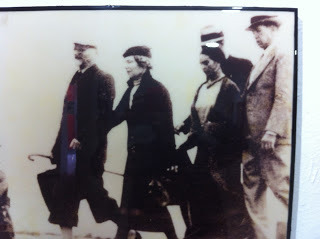 Frida and Trotsky had an affaire and they passed love notes to each other hidden in books. Diego and Frida built higher garden walls and thickened ceiling for Trotsky, but Stalin was unrelenting in his harassment and pursuit of Trotsky and later Trotsky was brutally murdered in a house around the corner in the same neighbourhood.Frida had numerous other lovers too, among them Nickolas Murray, the photographer “her adorable Nick” an enduring love, Georgia O’Keefe and Jacquelina Camba Noquchi. She was discrete with her love affaires.
Frida and Trotsky had an affaire and they passed love notes to each other hidden in books. Diego and Frida built higher garden walls and thickened ceiling for Trotsky, but Stalin was unrelenting in his harassment and pursuit of Trotsky and later Trotsky was brutally murdered in a house around the corner in the same neighbourhood.Frida had numerous other lovers too, among them Nickolas Murray, the photographer “her adorable Nick” an enduring love, Georgia O’Keefe and Jacquelina Camba Noquchi. She was discrete with her love affaires.
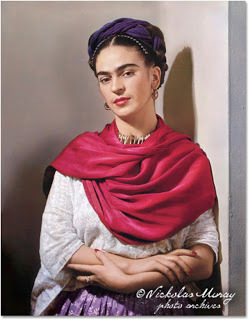 Portrait of Frida by Nicolas Murray But she did not forget her inner child. Her house still has the dolls that she kept all her life and the puppets and theatres she played with. Diego brought her puppets to hospital. There was something dream-like about her work, where she expressed herself without the reason or rational which attracted the surrealist Andre Breton to her.He wrote for her catalogue.“The art of Frida Kahlo is a ribbon around a bomb”In 1934 Breton also protested against the threat to expel Trotsky from France where Trotsky had been recently exiled. He referred to Trotsky several times in his ‘The Political Position of Surrealism’ citing his revolutionary aim to “win every man’s right not only to bread but to poetry” He recognised Frida Kahlo as being “delicately situated at that point of intersection between the political (philosophical) line and the artistic line” He used her art to reinforce Surrealism’s call for a ‘single revolutionary consciousness’ Frida could also connected to the spirituality of pre-hispanic cultures. The Aztecs and their “magical beings or spirits”. These ancient Mexicans had myths and legends of their own, such as the ritual of the ingestion of the peyote. This mission was spiritual in commune with the gods. Antonin Artaud tried desperately to participate in such cultural, social, and political life of Mexico, determined to find its primitive spirit. He said“The one that cannot see what is, because nothing exists in reality, but which, by the brush or pen, reproduces what it supposes, and what it supposes is always in the measure of its limitless imagination”In ‘Souvenir du Mexique’ Breton described Mexico as “Red land, Virgin land, all soaked with the most generous blood, land where man’s life is priceless yet ready as the agave (always its best expression) to consume itself in a flowering of desire and danger!” He claimed Aztec culture was the foundation of modern Mexican cultural revolution, while “the power of conciliating life and death” was the main attraction that ‘lures us to Mexico’ Zopotec’s love of independence inspired Breton’s adventurer’s turn of phrase and conflation of the revolutionary spirit of France and that of Latin America as well as his fascination with Kahlo’s Tehuana dress (the typical dress of the Isthmus Zapotec women)In Diego’s bedroom we see his hat and his dungarees and his bed. Devoted companions, Frida and Diego no longer slept together as Diego snored. But in this ground floor room, he could come and go as he pleased, to do his true love, his ‘obrero’Frida said of him: “Diego is neither defeatist nor downcast. He is, first and foremost, a researcher, a builder and above all, an architect… No matter whether his composition is a painting or a house or an argument”She said to him: “Never in life I will forget your presence. You found me turned apart and you took me back full and complete”Rivera’s admiration was mutual. He said that Kahlo’s art “had no precedent in the history of art – paintings which exalted the feminine qualities of endurance to truth, reality, cruelty and suffering” “Every moment he is my child” Frida said of him.
Portrait of Frida by Nicolas Murray But she did not forget her inner child. Her house still has the dolls that she kept all her life and the puppets and theatres she played with. Diego brought her puppets to hospital. There was something dream-like about her work, where she expressed herself without the reason or rational which attracted the surrealist Andre Breton to her.He wrote for her catalogue.“The art of Frida Kahlo is a ribbon around a bomb”In 1934 Breton also protested against the threat to expel Trotsky from France where Trotsky had been recently exiled. He referred to Trotsky several times in his ‘The Political Position of Surrealism’ citing his revolutionary aim to “win every man’s right not only to bread but to poetry” He recognised Frida Kahlo as being “delicately situated at that point of intersection between the political (philosophical) line and the artistic line” He used her art to reinforce Surrealism’s call for a ‘single revolutionary consciousness’ Frida could also connected to the spirituality of pre-hispanic cultures. The Aztecs and their “magical beings or spirits”. These ancient Mexicans had myths and legends of their own, such as the ritual of the ingestion of the peyote. This mission was spiritual in commune with the gods. Antonin Artaud tried desperately to participate in such cultural, social, and political life of Mexico, determined to find its primitive spirit. He said“The one that cannot see what is, because nothing exists in reality, but which, by the brush or pen, reproduces what it supposes, and what it supposes is always in the measure of its limitless imagination”In ‘Souvenir du Mexique’ Breton described Mexico as “Red land, Virgin land, all soaked with the most generous blood, land where man’s life is priceless yet ready as the agave (always its best expression) to consume itself in a flowering of desire and danger!” He claimed Aztec culture was the foundation of modern Mexican cultural revolution, while “the power of conciliating life and death” was the main attraction that ‘lures us to Mexico’ Zopotec’s love of independence inspired Breton’s adventurer’s turn of phrase and conflation of the revolutionary spirit of France and that of Latin America as well as his fascination with Kahlo’s Tehuana dress (the typical dress of the Isthmus Zapotec women)In Diego’s bedroom we see his hat and his dungarees and his bed. Devoted companions, Frida and Diego no longer slept together as Diego snored. But in this ground floor room, he could come and go as he pleased, to do his true love, his ‘obrero’Frida said of him: “Diego is neither defeatist nor downcast. He is, first and foremost, a researcher, a builder and above all, an architect… No matter whether his composition is a painting or a house or an argument”She said to him: “Never in life I will forget your presence. You found me turned apart and you took me back full and complete”Rivera’s admiration was mutual. He said that Kahlo’s art “had no precedent in the history of art – paintings which exalted the feminine qualities of endurance to truth, reality, cruelty and suffering” “Every moment he is my child” Frida said of him.
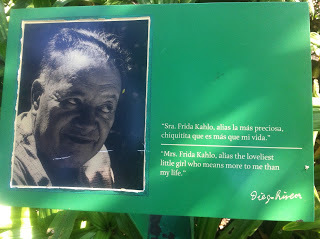 In her effort to please Diego’s stomach, Frida learned to master Diego’s favourite dishes from Lupé Marine, Diego’s previous wife. The kitchen is a traditional Mexican kitchen with no fridge. The oven is authentic (just logs under a tiled box) and they collects pots on travels, with dishes large enough for a whole village and big ceramic dishes. They would have grand dinner parties. Even Eisenstein dined with them. It was said that people “Came for Diego but stayed on because of Frida” all recognising her and enchanted by her personality.Then, up some steps is Frida’s studio. She had to be carried up the steps. In there, there is still the empty wheel chair, the mirror, the powder paints, her easel (a gift from Rockafellor) and a poster showing ‘Intra-Uterine life’, showing the process of growth from conception to birth.
In her effort to please Diego’s stomach, Frida learned to master Diego’s favourite dishes from Lupé Marine, Diego’s previous wife. The kitchen is a traditional Mexican kitchen with no fridge. The oven is authentic (just logs under a tiled box) and they collects pots on travels, with dishes large enough for a whole village and big ceramic dishes. They would have grand dinner parties. Even Eisenstein dined with them. It was said that people “Came for Diego but stayed on because of Frida” all recognising her and enchanted by her personality.Then, up some steps is Frida’s studio. She had to be carried up the steps. In there, there is still the empty wheel chair, the mirror, the powder paints, her easel (a gift from Rockafellor) and a poster showing ‘Intra-Uterine life’, showing the process of growth from conception to birth.
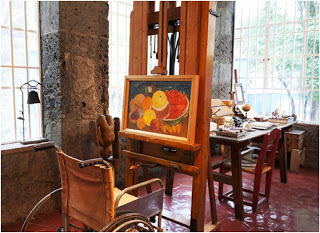 All her books are annotated, suggesting her intellectual curiosity and reveal her deep interest in pre-Hispanic cultures. Her file boxes are decorated (each picture refers to what’s inside – the devil with horns is Rivero’s box)Then we come to her bedroom. We see the bed where she first began to paint after her accident in a tram crash. This is the same bed in which she would die.Frida’s ashes are on the dressing table in pre-hispanic urn with design of toad representing Diego ‘the toad-frog’ Diego has written on it: “May she rest in ashes alive in my heart”It’s as if she’s resting symbolically inside her beloved Diego.
All her books are annotated, suggesting her intellectual curiosity and reveal her deep interest in pre-Hispanic cultures. Her file boxes are decorated (each picture refers to what’s inside – the devil with horns is Rivero’s box)Then we come to her bedroom. We see the bed where she first began to paint after her accident in a tram crash. This is the same bed in which she would die.Frida’s ashes are on the dressing table in pre-hispanic urn with design of toad representing Diego ‘the toad-frog’ Diego has written on it: “May she rest in ashes alive in my heart”It’s as if she’s resting symbolically inside her beloved Diego.
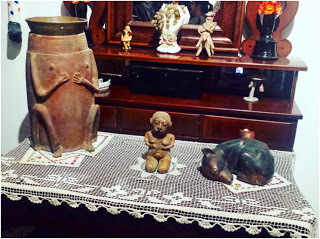 We see the wardrobes for her clothing, which was important to her art. Her mother was a seamstress and so knew dressing skills. Frida had 300 items of clothes from different regions of Mexico and wore the folkloric work in her work.
We see the wardrobes for her clothing, which was important to her art. Her mother was a seamstress and so knew dressing skills. Frida had 300 items of clothes from different regions of Mexico and wore the folkloric work in her work.
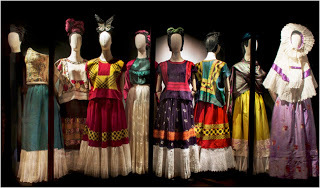 Her Tehuana dress was her signature dress, a hybrid representing her own mixed European and Mexican bloods. The dress symbolised a matriarchal society which was administered and dominated by women. The dress represents female power and independence and Diego was fond of powerful Zapote women. Frida was able to perceive the semiotic quality of the clothing.In an outbuilding of the house, there are the corsets and the diary, telling of her pain and her despair.
Her Tehuana dress was her signature dress, a hybrid representing her own mixed European and Mexican bloods. The dress symbolised a matriarchal society which was administered and dominated by women. The dress represents female power and independence and Diego was fond of powerful Zapote women. Frida was able to perceive the semiotic quality of the clothing.In an outbuilding of the house, there are the corsets and the diary, telling of her pain and her despair.
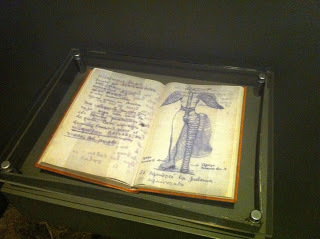
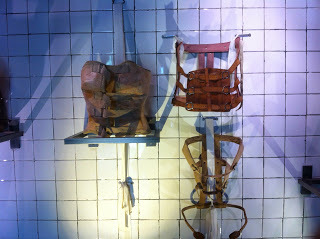 We recall the pain that Frida suffered, with her polio, her back problems and the dominoing effects of gangrene. Like Christ on the cruxifix, there is something of this same agony expressed by her and she often drank a bottle of cognac, lived off painkillers and had 32 corsets during her life. And yet Frida Kahlo managed to transform her pain and oppression.From a Christian viewpoint, she transformed her pain into love. St Augustine argued that Christ suffering on the cross was in fact a joyous occasion.
We recall the pain that Frida suffered, with her polio, her back problems and the dominoing effects of gangrene. Like Christ on the cruxifix, there is something of this same agony expressed by her and she often drank a bottle of cognac, lived off painkillers and had 32 corsets during her life. And yet Frida Kahlo managed to transform her pain and oppression.From a Christian viewpoint, she transformed her pain into love. St Augustine argued that Christ suffering on the cross was in fact a joyous occasion.
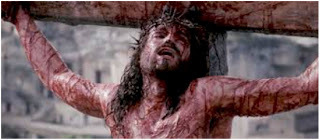 St. Augustine speaks of going to the cross as a bridegroom to his bride. Joseph Campbell speaks of self‐preservation as only the second law of life. The first law is that you and the other are one. That the Kingdom of God is within us. And Easter and Passover remind us that we have to let go in order to enter it.
St. Augustine speaks of going to the cross as a bridegroom to his bride. Joseph Campbell speaks of self‐preservation as only the second law of life. The first law is that you and the other are one. That the Kingdom of God is within us. And Easter and Passover remind us that we have to let go in order to enter it.
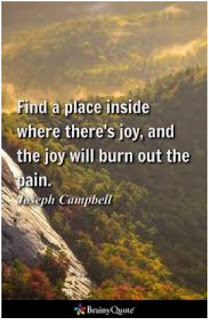
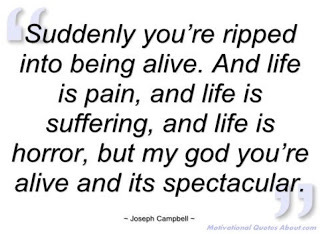 Perhaps this is what Frida Kahlo achieved and it is this what has made her such an inspiration: it is her political engagement, her spiritual sensitivity, her historical rootedness, her love of life and art that are all aspects of her character which helped her to rise up now letting her colourful feathers fall, serving as ornaments in the sacred dance The life of a man who has perfected himself is a bright light for the people of earth, who look up to him as an example and this is why Frida Kahlo has become a symbol in Mexico of saint-like realms, showing us how we can transform adversities into creativity.
Perhaps this is what Frida Kahlo achieved and it is this what has made her such an inspiration: it is her political engagement, her spiritual sensitivity, her historical rootedness, her love of life and art that are all aspects of her character which helped her to rise up now letting her colourful feathers fall, serving as ornaments in the sacred dance The life of a man who has perfected himself is a bright light for the people of earth, who look up to him as an example and this is why Frida Kahlo has become a symbol in Mexico of saint-like realms, showing us how we can transform adversities into creativity.
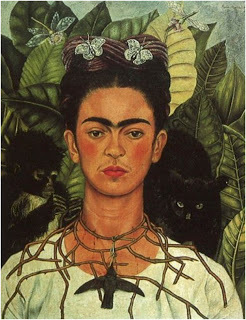

Published on March 23, 2017 12:36
October 26, 2016
PERSONA at the Musée du Quai Branly, Paris. How can we see the unseen?
PERSONA at the Musee du Quai Branly, Paris, exhibits a wide range of artifacts that are physical displays of what cannot actually be seen.
What is amazing about this exhibition is that it brings up ideas about how, as a people, we have the capacity to reach a higher dimension… and various physical objects on show try to capture, communicate or reach those inner powers and perceptions that we hold, but that most of us do not use or are trapped from using by attachments or limited thinking.
How does the exhibition draw our attention to such powers and potentials?
It begins with Saint Anthony’s trial. The Egyptian monk put himself in a dark cave and yet saw a whole lot of images in the nothingness.
Often he would glance up from his prayers to see Satan hovering before him in the gloom of his abandoned fort. And Satan was hard to recognize; usually he looked like the things Anthony missed most.
The idea was that the more his faith and love grew, the less susceptible he was to attachments flashed at him by the devil.
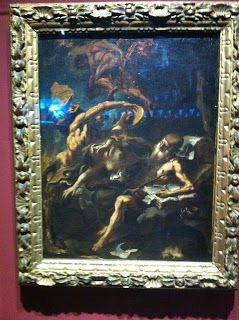
The exhibition tries to show that human beings have an inner life or an ability to create visual things which illustrate the inner unseen forces.
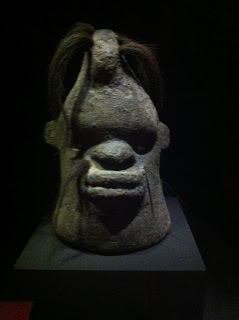
It shows an experiment where, in 48 hours of total isolation (BBC documentary) 6 people, placed in a cell in total darkness and silence, were deprived of sensuary stimulus. Their reactions were filmed and observed throughout. Some of them experience hallucinations equal to those happening in deserts or high altitudes, showing that these ‘presences’ appear in solitary situations. The exhibition, through telling of the artefacts, awakens those universally felt senses.
Then we see the famous experiment carried out in 1944 by two psychologiest, Fritz Heider and Marianne Simmel, showing how, when looking at simple geometric figures projected onto a screen and given random movements, onlookers were unable to stop themselves attributing intentions and imagining a story to describe their actions. More broadly we have a spontaneous tendency to attribute feelings and thoughts to barely anthropomorphic faces.
Rare old films remind us of our ability to awaken inner heroic deities through the site of carvings, sculptures and even films. We are reminded of Jack Arnold in ‘The Incredible Shrinking Man’, where, contaminated by a mysterious gas, Scott, the hero of the film, gradually shrinks to the size of several centimetres. At first his family look after him and help him adapt to his new size, but then following the attack of a cat in the house, he finds himself in a cave, smaller than before and lost. After a terrible combat with a spider, he finished by accepting his destiny to be miniscule, thrown into the immensity of the universe.
The exhibition tries to show how artworks are often methods of connecting us with powers and presences beyond our worldly sense. We see Jean-Jacques Lebel ‘Radio Momo’ intended to reach the dead. Lebel had chosen to add two aerials to a real scull, as an altar that is to talk to the dead Antonin Artaud, but brought alive by his own work of art. For Lebel, are is a form of ‘telepathy interposed by work’ (although Artaud never yet has spoken into the instrument)
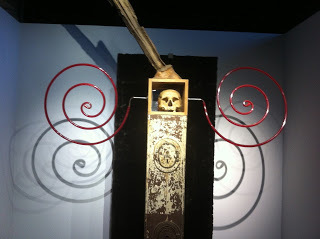
Many of the objects, like statues, only depict the inhabited deity when you open their eyes, and are only likened to people through very specific animation rituals, and in the context of precise situations, revealing themselves intermittently, and creating effects of presence/absence.
At times the entity becomes materialized, at others it becomes liquefied, or is transformed, by way of incarnations which are never exactly equivalent. The entity thus becomes a potential, uncontrollable presence, which must be tamed and summoned by different methods: words (appeals, challenges, warnings, songs of seduction…) forms of care and offerings, traps (witch bombs, fairy traps…) and other unexpected techniques which make it possible to draw the attention of a presence and establish a relation with it.It is interesting to understand that inner transformation can be inspired by outer perception.
Mythical symbols, throughout time and space, have urged the inner self to evolve.
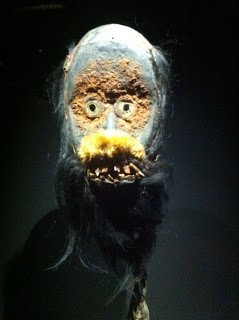
On the subject of the physical artefacts awakening the unseen, Joseph Campbell said once:“The Virgin birth is nothing to do with a biological problem and the promised land has nothing to do with real estate. The virgin birth symbolises the birth in the heart of a spiritual life.”
This exhibition points out that the symbols of artist works and artefacts can provoke inner changes and transformations.
What is brave about this exhibition is that it tries to point out that there exists a lot that we do not see. A lot of our life we live with ‘no inner life’
Referring to Campbell, “All of the deities are projections of the psychological powers and they are within you and not out there. A transcendent energy consciousness informs the whole world and informs you”
All life has to come to us through aesthetic and logic, time and space: we think within the frame, such as Kant’s ‘Critique of Pure Reason’ How do we transcend that ‘that to which words or thoughts do not reach’?
Campbell believed that “Our religions are religions of exile”In the Gospel according to Thomas (which was left out of the bible) Thomas said, when asked the question: “When will the kingdom come?”His answer was: “the kingdom of the father is spread on the earth and people do not see it”
Kristnamurti believed in pure perception that acts. Pure perception, that is not related to time or thought, can break us away the pattern of the brain in which human beings have been caught for millions of years.
This exhibition tries to show some of those artistic methods for doing this very same thing.Mori’s concept of the Uncanny Valley has become part and parcel of the discourse within the fields of humanoid robotics engineering, the film industry, culture studies, and philosophy, most notably the philosophy of transhumanism.
Jack Vanarsky Toporgraphie 1998
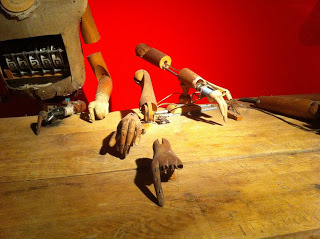
In this paper, the concept of the Uncanny Valley is discussed in terms of the contemporary Japanese cultural milieu relating to humanoid robot technology, and the on-going roboticization of human culture. For Masahiro Mori, who is also the author of The Buddha in the Robot(1981), the same compassion that we ought to offer to all living beings, and Being itself, we ought to offer to humanoid robots.
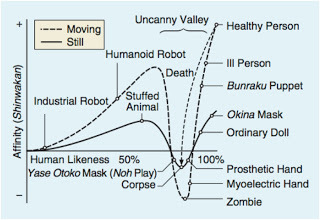
The range of strange objects, masks, models, awaken strangeness and thus dissolve those set knowledge’s, experiences and thoughts.
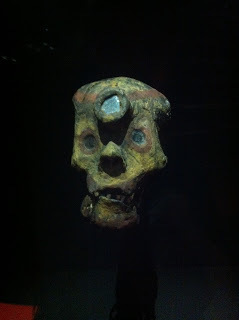
An inner life is awakened.
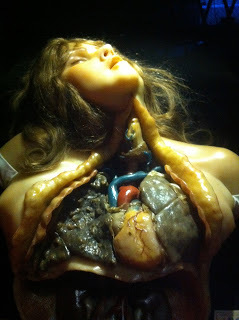
This exhibition reminds us of the timelessness of creation and how, throughout all lands and via all minds, powers beyond the world perceived by physical senses, there is more.
“When man becomes aware of the movement of his own consciousness he will see the division between the thinker and the thought, the observer and the observed, the experiencer and the experience” said Kristnamurti, “He will discover that this division is an illusion. Then only is there pure observation which is insight without any shadow of the past. This timeless insight brings about a deep radical change in the mind”
“I saw the angel in the marble and carved until I set him free” said Michelangelo about his creation. Actors and dancers are said to be sculpturers of snow. The inner life of another enters them.The exhibition made me think of this brilliant piece of dance by Anna Pavlova, where she is a swan. Just her pure observation of the swan, and the transformation into it, reveals how well she could awaken her mind to the treasures out there. Anna Pavlova: Dying Swan
The exhibition carries you through the confusion that exists between human and non-human, and the specific and personalised relationship that connects them, in a wide variety of cultures. You come away feeling denationalised by a feeling of an inner oneness with something beyond your individual self and beyond your preconceived notions that you had on entering the exhibition.
It is a vast anthropological study of what is not seen yet seen, and how in fact the constraints of our physical awareness can be vehicles that make us further aware, perceptive and observant , connecting to our inner life on earth and how this makes us live richer, happier, more peaceful lives.

What is amazing about this exhibition is that it brings up ideas about how, as a people, we have the capacity to reach a higher dimension… and various physical objects on show try to capture, communicate or reach those inner powers and perceptions that we hold, but that most of us do not use or are trapped from using by attachments or limited thinking.
How does the exhibition draw our attention to such powers and potentials?
It begins with Saint Anthony’s trial. The Egyptian monk put himself in a dark cave and yet saw a whole lot of images in the nothingness.
Often he would glance up from his prayers to see Satan hovering before him in the gloom of his abandoned fort. And Satan was hard to recognize; usually he looked like the things Anthony missed most.
The idea was that the more his faith and love grew, the less susceptible he was to attachments flashed at him by the devil.

The exhibition tries to show that human beings have an inner life or an ability to create visual things which illustrate the inner unseen forces.

It shows an experiment where, in 48 hours of total isolation (BBC documentary) 6 people, placed in a cell in total darkness and silence, were deprived of sensuary stimulus. Their reactions were filmed and observed throughout. Some of them experience hallucinations equal to those happening in deserts or high altitudes, showing that these ‘presences’ appear in solitary situations. The exhibition, through telling of the artefacts, awakens those universally felt senses.
Then we see the famous experiment carried out in 1944 by two psychologiest, Fritz Heider and Marianne Simmel, showing how, when looking at simple geometric figures projected onto a screen and given random movements, onlookers were unable to stop themselves attributing intentions and imagining a story to describe their actions. More broadly we have a spontaneous tendency to attribute feelings and thoughts to barely anthropomorphic faces.
Rare old films remind us of our ability to awaken inner heroic deities through the site of carvings, sculptures and even films. We are reminded of Jack Arnold in ‘The Incredible Shrinking Man’, where, contaminated by a mysterious gas, Scott, the hero of the film, gradually shrinks to the size of several centimetres. At first his family look after him and help him adapt to his new size, but then following the attack of a cat in the house, he finds himself in a cave, smaller than before and lost. After a terrible combat with a spider, he finished by accepting his destiny to be miniscule, thrown into the immensity of the universe.
The exhibition tries to show how artworks are often methods of connecting us with powers and presences beyond our worldly sense. We see Jean-Jacques Lebel ‘Radio Momo’ intended to reach the dead. Lebel had chosen to add two aerials to a real scull, as an altar that is to talk to the dead Antonin Artaud, but brought alive by his own work of art. For Lebel, are is a form of ‘telepathy interposed by work’ (although Artaud never yet has spoken into the instrument)

Many of the objects, like statues, only depict the inhabited deity when you open their eyes, and are only likened to people through very specific animation rituals, and in the context of precise situations, revealing themselves intermittently, and creating effects of presence/absence.
At times the entity becomes materialized, at others it becomes liquefied, or is transformed, by way of incarnations which are never exactly equivalent. The entity thus becomes a potential, uncontrollable presence, which must be tamed and summoned by different methods: words (appeals, challenges, warnings, songs of seduction…) forms of care and offerings, traps (witch bombs, fairy traps…) and other unexpected techniques which make it possible to draw the attention of a presence and establish a relation with it.It is interesting to understand that inner transformation can be inspired by outer perception.
Mythical symbols, throughout time and space, have urged the inner self to evolve.

On the subject of the physical artefacts awakening the unseen, Joseph Campbell said once:“The Virgin birth is nothing to do with a biological problem and the promised land has nothing to do with real estate. The virgin birth symbolises the birth in the heart of a spiritual life.”
This exhibition points out that the symbols of artist works and artefacts can provoke inner changes and transformations.
What is brave about this exhibition is that it tries to point out that there exists a lot that we do not see. A lot of our life we live with ‘no inner life’
Referring to Campbell, “All of the deities are projections of the psychological powers and they are within you and not out there. A transcendent energy consciousness informs the whole world and informs you”
All life has to come to us through aesthetic and logic, time and space: we think within the frame, such as Kant’s ‘Critique of Pure Reason’ How do we transcend that ‘that to which words or thoughts do not reach’?
Campbell believed that “Our religions are religions of exile”In the Gospel according to Thomas (which was left out of the bible) Thomas said, when asked the question: “When will the kingdom come?”His answer was: “the kingdom of the father is spread on the earth and people do not see it”
Kristnamurti believed in pure perception that acts. Pure perception, that is not related to time or thought, can break us away the pattern of the brain in which human beings have been caught for millions of years.
This exhibition tries to show some of those artistic methods for doing this very same thing.Mori’s concept of the Uncanny Valley has become part and parcel of the discourse within the fields of humanoid robotics engineering, the film industry, culture studies, and philosophy, most notably the philosophy of transhumanism.
Jack Vanarsky Toporgraphie 1998

In this paper, the concept of the Uncanny Valley is discussed in terms of the contemporary Japanese cultural milieu relating to humanoid robot technology, and the on-going roboticization of human culture. For Masahiro Mori, who is also the author of The Buddha in the Robot(1981), the same compassion that we ought to offer to all living beings, and Being itself, we ought to offer to humanoid robots.

The range of strange objects, masks, models, awaken strangeness and thus dissolve those set knowledge’s, experiences and thoughts.

An inner life is awakened.

This exhibition reminds us of the timelessness of creation and how, throughout all lands and via all minds, powers beyond the world perceived by physical senses, there is more.
“When man becomes aware of the movement of his own consciousness he will see the division between the thinker and the thought, the observer and the observed, the experiencer and the experience” said Kristnamurti, “He will discover that this division is an illusion. Then only is there pure observation which is insight without any shadow of the past. This timeless insight brings about a deep radical change in the mind”
“I saw the angel in the marble and carved until I set him free” said Michelangelo about his creation. Actors and dancers are said to be sculpturers of snow. The inner life of another enters them.The exhibition made me think of this brilliant piece of dance by Anna Pavlova, where she is a swan. Just her pure observation of the swan, and the transformation into it, reveals how well she could awaken her mind to the treasures out there. Anna Pavlova: Dying Swan
The exhibition carries you through the confusion that exists between human and non-human, and the specific and personalised relationship that connects them, in a wide variety of cultures. You come away feeling denationalised by a feeling of an inner oneness with something beyond your individual self and beyond your preconceived notions that you had on entering the exhibition.
It is a vast anthropological study of what is not seen yet seen, and how in fact the constraints of our physical awareness can be vehicles that make us further aware, perceptive and observant , connecting to our inner life on earth and how this makes us live richer, happier, more peaceful lives.

Published on October 26, 2016 14:43
August 29, 2016
Ways into SKETCHING
You want to draw something, anything, where do you begin?
Sketching is something human beings have done since time began.
Prehistoric mortals drew the animals they hunted: wooly mammoths, deer, birds, fish.
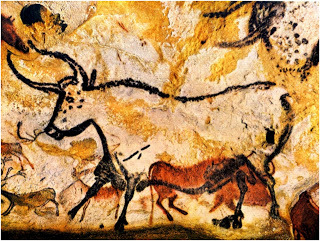
It's a question of looking first. Letting yourself turning into a presence. It's a question of noticing and observing. It's a question on dwelling on the beauty of something.
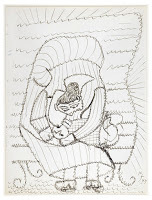 Picasso: Mother Nursing a child 1944
Picasso: Mother Nursing a child 1944
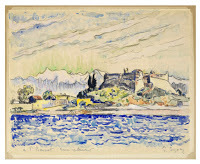 Paul Signac View of Calvi, Corsica 1935
Paul Signac View of Calvi, Corsica 1935
Hemmingway said "If you know a thing, it is in your work, whether you write about it or not" It is the same with sketching. Sketching and writing are methods of telling. You tell about something visual. And the more you look and the more you know a place, the more will come out.
Then, just let the pencil record, without making any judgements. Record its shape, its shadows, its details. The drawing you produce is a testament of having been in a place. It's something you record, and pass on, it's a gift for the future: a proof of having witnessed something at a certain time and place.
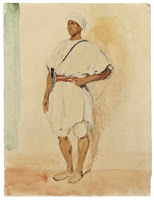 A Standing Moroccan man Eugene Delacroix 1832
A Standing Moroccan man Eugene Delacroix 1832
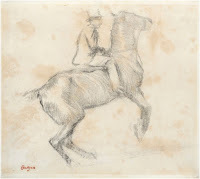 Horse and Rider, Edgar Degas
Horse and Rider, Edgar Degas
You must never make a judgement of what is being drawn. That is not for you. All you must do is allow the pencil to keep going on its journey of tracing the observations of your eye.
Writer Natalie Goldberg says: 'Drawing relaxes and focusses the restless mind' It gets you creating from a non-rational place. It jostles your mind out of logic. You must let something larger take over and give up control.
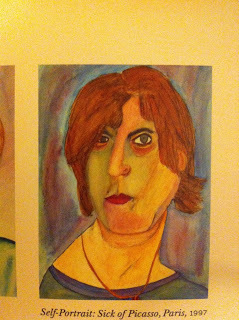 self portrait, Natalie Goldberg
self portrait, Natalie Goldberg
You must always finish a drawing. Never let self-criticism have a say. Keep going, right until you feel that you have told the whole picture and shown it all in its glory. The longer you look at it, the more likely the view before you will insist on being revealed, in all its glory. It will not want to be deprived of a vital garment: an elongated shadow or pretty ray of sunshine.
SUMMER SKETCHES:
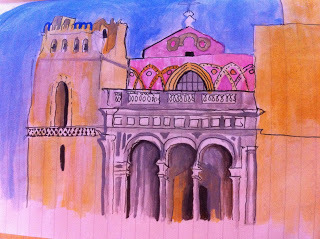
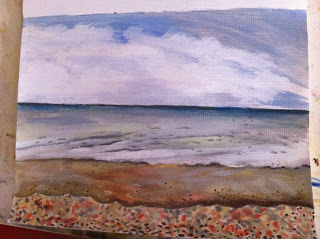
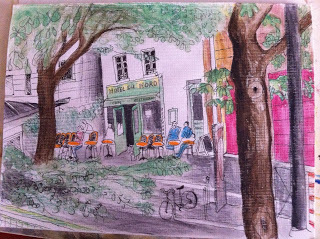
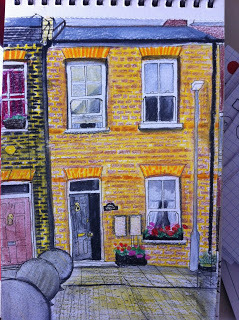
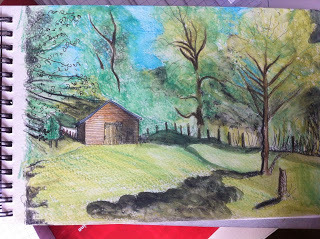
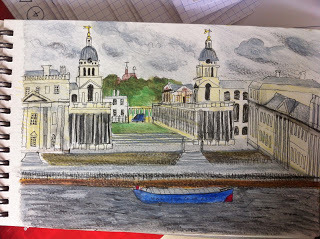
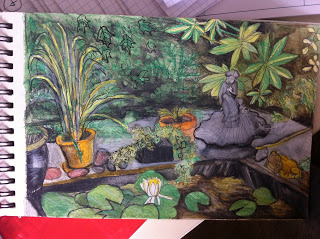
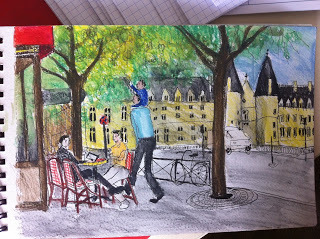
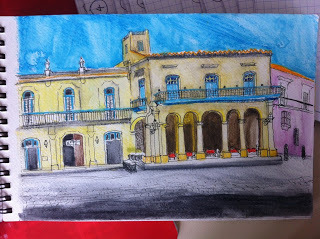
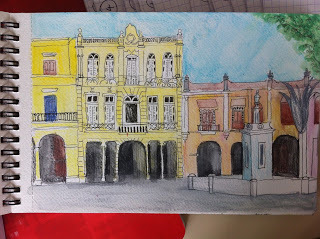
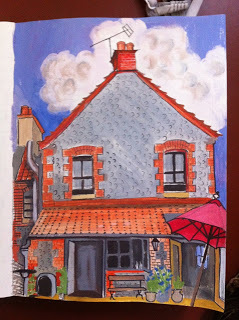
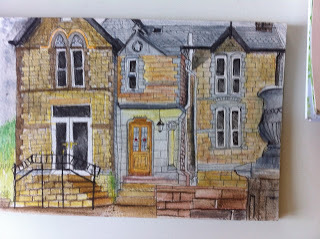
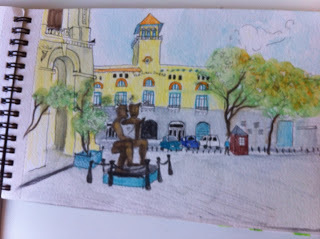
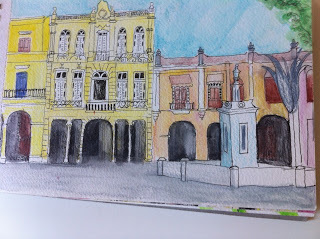
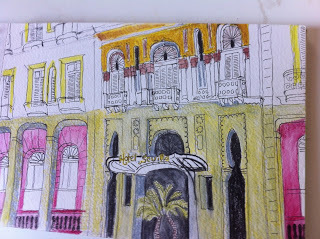
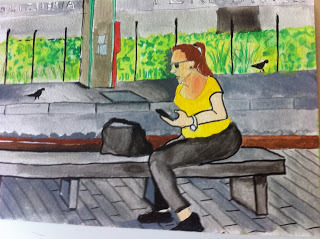
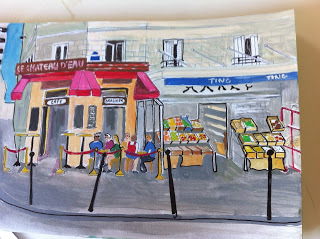
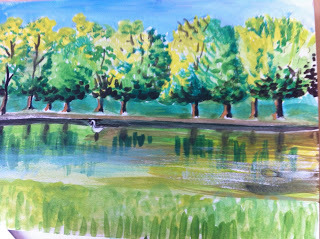
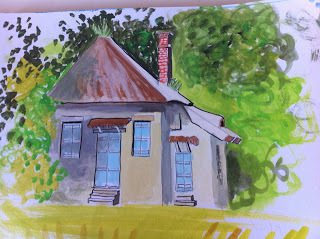

Sketching is something human beings have done since time began.
Prehistoric mortals drew the animals they hunted: wooly mammoths, deer, birds, fish.

It's a question of looking first. Letting yourself turning into a presence. It's a question of noticing and observing. It's a question on dwelling on the beauty of something.
 Picasso: Mother Nursing a child 1944
Picasso: Mother Nursing a child 1944
 Paul Signac View of Calvi, Corsica 1935
Paul Signac View of Calvi, Corsica 1935 Hemmingway said "If you know a thing, it is in your work, whether you write about it or not" It is the same with sketching. Sketching and writing are methods of telling. You tell about something visual. And the more you look and the more you know a place, the more will come out.
Then, just let the pencil record, without making any judgements. Record its shape, its shadows, its details. The drawing you produce is a testament of having been in a place. It's something you record, and pass on, it's a gift for the future: a proof of having witnessed something at a certain time and place.
 A Standing Moroccan man Eugene Delacroix 1832
A Standing Moroccan man Eugene Delacroix 1832
 Horse and Rider, Edgar Degas
Horse and Rider, Edgar Degas You must never make a judgement of what is being drawn. That is not for you. All you must do is allow the pencil to keep going on its journey of tracing the observations of your eye.
Writer Natalie Goldberg says: 'Drawing relaxes and focusses the restless mind' It gets you creating from a non-rational place. It jostles your mind out of logic. You must let something larger take over and give up control.
 self portrait, Natalie Goldberg
self portrait, Natalie GoldbergYou must always finish a drawing. Never let self-criticism have a say. Keep going, right until you feel that you have told the whole picture and shown it all in its glory. The longer you look at it, the more likely the view before you will insist on being revealed, in all its glory. It will not want to be deprived of a vital garment: an elongated shadow or pretty ray of sunshine.
SUMMER SKETCHES:




















Published on August 29, 2016 15:03
August 18, 2016
July 2, 2016
What is the point of having a brain in the UK?
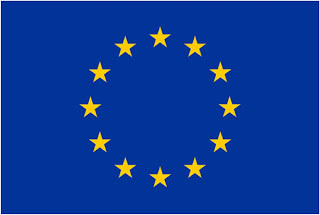
With the landed gentry, the BBC and other media, large corporations, the government and the Blairite MPs all in control of the running of Britain, what is the point of anyone else there having a brain when they will just get squashed, bullied and poorly represented?
Other referendum callers were the Nazis in Germany in the early 1930s, who caused, to their advantage, a country full of division. This division resulted in a vicious government under Adolf Hitler. The people lost all sense of themselves, lost all compassion and humanity for other nationals. The people of Germany were a divided, ignorant people, controlled by a malicious, narcissistic controller.
Do we want this for Britain? Divided, confused, in chaos, as it currently is becoming?Over the years we’ve build a European Union that is complicated but constructive, with projects for markets, ecology, education and peace.
Churchill, de Gaulle and so many good people worked hard to create this European Community.
So, leaving the EU, has Britain just sold its soul? Have the people forgotten about love, the love for a united Europe, a project begun by Winston Churchill?
Does the British government really want its people to use their brains? Why are they testing the peoples’ brains when at their most delicate and formative? The small 6 and 7 year old children? When even when British teachers do not agree with doing these SATS tests, but it is IMPOSTED by the British government. Money for libraries and books is being used instead for this testing, causing exhausted teachers and burnt out schools.
6 year old UK brains must instead meet their ‘standards’, but such cruelty makes one wonder if peoples’ brain-use really is a government priority? In other European countries, such as France, 6 year olds are NOT tested. What is important for children at this age is learning the pleasure of books and stories, enjoying writing skills, learning number patterns. TESTING at this age would be considered an appalling thing to do to both a child and a teacher! The priority of learning is love of reading books, writing and learning.
But is it harder for a government to take control when a people can think, use their brains and know their own minds? And is it harder to ‘take control’ when Britain is in the EU? Is that why people were tricked into believing the 350 million for NHS lie so they would vote LEAVE?
The Europe we have built, with love, cooperation and sensitivity to others’ needs is a great thing. Will Britain just be victims of the narcissists living in this world, the UKIP, the TRUMPS, the Le PENNS who want power? Will they be able to get their narcissistic supply from destroying, dividing, controlling all that has been constructed by good, constructive, honest people whose effects in the world have been heroic?
Will we just watch Labour's Jeremy Corbyn get bullied by the establishment and media? The man who got Labour the greatest REMAIN vote of all the parties! With an approaching report and possible trial for war crimes in Iraq, it is becoming apparent too that those MPs revolting against him are simply worried that he will assist in the trial against them.
Jeremy Corbyn is like Robin Hood of Britain. At grassroots level, it has been he who has inspired thousands and caused the largest labour party membership in its history. It’s an achievement when power, money and hypnotic powers of the media have all been the sheriff of Nottingham.
Let’s learn from history. The Trumps, Le Penns and the Ukips can step in to manipulate a weakened, divided population. Leaving the EU, we are letting them have more power. Let’s not forget the work of all those people who built a united Europe. Let’s be wary of selling our souls and letting the demagogues and narcissists feed their own needs, greeds and narcissistic supplies. Back REMAIN politicians! Back Jeremy Corbyn!
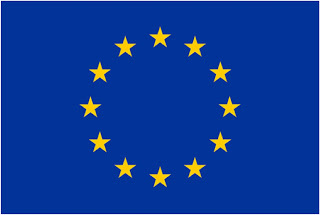

Published on July 02, 2016 15:44


